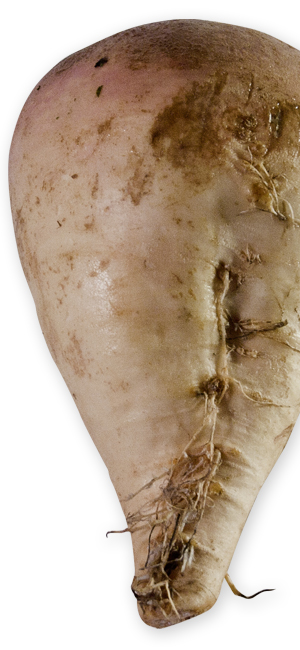| < Vegetables | |
RutabagaBrassica napobrassicaSweden's major contribution to world agriculture, the rutabaga (or 'Swedish Turnip") , galvanized the interest of antebellum American farmers because of its productivity. One of the resonant statistics of the 1840s was J. W. Brewster's harvest result from an acre of land cultivated in successive years by corn and rutabaga. The soil generated 50 bushels of corn (approximately 400 feeds for livestock) versus 1 thousand bushels of rutabaga (or 5,500 feeds of 10 lbs. per animal). The result was simple enough for even dull farmers to grasp. If feeding livestock was your concern, the rutabaga was your plant. Only the Mangel Wurtzel (German Cattle Beet) rivaled the rutabaga for yield. And the rutabaga had one advantage over the mangel wurtzel—it tasted good to humans. The rutabaga (Swedish for 'root bag') was a root vegetable produced by a natural cross between a cabbage and a turnip. It was a fixture of Swedish agriculture since the 17th century and first attracted attention in England in the middle of the 18th century by reformers interested in improving animal husbandry in Great Britain. The English political economist William Cobbett publicized the virtues of the plant during his 1816-1818 sojourn in the United States. American experimentalists began working intensively with the plant in the late 1810s with the intention of determining which was the most profitable and advantageous crop for a diversified farm--potatoes, sugar beets, mangel wurtzels, carrots, turnips, or rutabagas? As with most comparative explorations, the results varied depending on local circumstances. Rutabagas had certain advantages in cultivation: its growing season was shorter than the other roots; it could be manured by plowing in a clover field after the clover hay had been cut (most other roots required a major application of animal dung), it remained vital in the heat of midsummer; and it harvested more easily than mangel wurtzel; its disadvantages lay in its poor productivity in clay soils, its susceptibility to the insect pests that afflicted turnips, particularly the turnip fly, and its occasional toughness. One matter that could not be decided until rather late in the 19th century was whether the rutabaga was more or less nutritious than the other roots, and the agricultural journals were filled with studies claiming different, sometimes greatly contradictory, findings. When used as cattle feed, the tops proved as palatable as the roots. Farmers chopped the roots with a spade, intermixed it with hay or silage, and winter fed the cattle, hogs, or sheep with the mixture. Horses preferred them steamed to raw. The literature for cooking rutabaga for feed is quite extensive, with various formula for intermixing with corn, or oats, or other grains. Comparatively, the discussion of the root as an object of human consumption is rather sparse. Often the rutabaga is lumped as a turnip and the cook is instructed to treat it as it would any other turnip, despite its more pronounced flavor. As table fare the rutabaga appealed more to home cooks than hotel professionals. It was one of the root vegetables included in a New England boiled dinner. It was boiled and mashed, sometimes mixed with mashed carrots in the Swedish style, more often with mashed potatoes. |
 |
